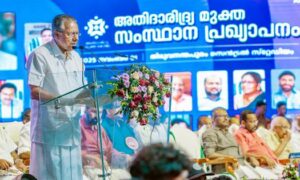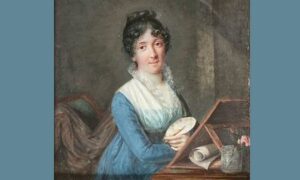
The ship approached the Bombay harbour early one morning in December 1951. As it moved forward sluggishly across “an enormous mass of liquid mercury, barely undulating”, Paz’s excitement grew. The morning fog gradually revealed the first vision of India to him in obscure outline. He saw the Gateway of India, an archway that was built in 1911 to welcome King George V and Queen Mary. In the years that followed, it welcomed overseas travellers, emphatically reinforcing their sense of arrival in India. It was also through this archway that the last British troops departed India in 1947. It was made in a revivalist architectural style that combines Mughal, Hindu and Gothic architectural elements, which is referred to as Indo-Saracenic. Paz’s first vision of India was made with an Orientalist disposition:
Behind the monument, floating in the warm air, was the silhouette of the Taj Mahal Hotel, an enormous cake, a delirium of the fin-de-siècle Orient fallen like a gigantic bubble, not of soap but of stone, on Bombay’s lap. I rubbed my eyes: was the hotel getting closer or farther away?
The Taj Mahal Hotel at Apollo Bunder, the one in which Paz stayed, is near the Gateway of India. Most heads of states from across the world tend to stay at the hotel. It never fails to fascinate its visitors with its eclectic architectural style and interior décor, a blend of European and Indian elements. “If this book were a memoir and not an essay,” he wrote, “I would devote pages to that hotel.” There are many stories and myths around the Taj Hotel about Jamshetji Tata’s inspiration for undertaking such a gigantic venture during the colonial years. Paz, in his excitement, consumed some of those fictitious, self-gratifying colonial accounts. Certainly, the hotel’s 240-foot-high dome, which predated the Gateway by two decades, was the first clear marker of Bombay Harbour that could be seen from the sea. The dome of the hotel is still an official triangulation point, along with a chimney and a rocky island for ships of the Indian Navy to fix their position in the harbour.
It is evident that Paz was captivated by the hotel’s passageways, which were “the corridors of a lavish, sinister, and endless dream … ostentatious and comfortable, vulgar and sublime … its unexpected nooks, its patios, terraces and gardens, both enchanting and dizzying.” The apt descriptions betray his attraction to the cohabitation of opposites in India. More than the architecture, the Indians inhabiting those spaces were described with a surrealist’s love of the exotic l’Orient:
…dark men with pointed moustaches and scimitars at their waists, women of amber-coloured skin, hair and eyebrows as black as crow’s wings and the huge eyes of lionesses in heat.
The heat. It is the overriding theme particularly during his first sojourn, in both his life and in poetry, literally and metaphorically. Though the temperature of Bombay in early December is considered a pleasant, or at least a bearable 32°C (90°F), Paz found the heat intolerable. Nevertheless, his intense enthusiasm drove him to an endless exploration of street life where he experienced social disparity, “saw monsters and was blinded by flashes of beauty”. His descriptions of his first sights and sounds of the city are graphically registered with a screenwriter’s skill even though the memoir was written more than 40 years after the event:
…huge grey and red buildings, a Victorian London growing among palm trees and banyans like a recurrent nightmare, leprous walls, four half-naked would-be saints daubed with paint, red betel stains on the sidewalk, horn battles between a taxi and a dusty bus … women in red, blue, yellow, deliriously coloured saris, some solar, some nocturnal, darkhaired women with bracelets on their ankles and sandals made not for the burning asphalt but for fields, monkeys in the cornices of the buildings, shit and jasmine, homeless boys … a stone daubed with red paint, at its feet a few faded flowers: the silhouette of the monkey god …
The city with its plethora of images impacted the poet so deeply that he had to pause and take stock of all that he had seen and heard. He rested at the foot of a huge banyan tree, overwhelmed by a farrago of “dizziness, horror, stupor, astonishment, joy, enthusiasm, nausea, inescapable attraction”. Recalling his favourite TS Eliot of “The Four Quartets”, he said to himself: Humankind cannot bear very much reality.
Before setting off on the train journey from Bombay to New Delhi, Paz stayed for a week in Bombay. On the third day, he decided to visit the Elephanta Caves, located on the Elephanta Island at a distance of 10 km from the Gateway of India, which is reached through a 45-minute boat ride. It is a collection of cave temples carved out of solid basalt rock, five of which are Hindu, completed around the sixth century CE. Most of them are dedicated to Lord Shiva in his various forms: as trimurti (triple-headed, representing the aspects of creation, preservation and destruction), as nataraja (the divine dancer who holds together the cosmos with the rhythm of his dance) and as yogishvara (the lord of yogis or meditation). The caves also have a few Buddhist stupa mounds that date back to the second century BCE. Though they bear the marks of great artwork, most of the sculptures have been defaced by Portuguese soldiers who had a military base on the island and used the sculptures for target practice. Paz had read Nehru’s comments that “the trimurti in the Elephanta caves might well be the many-faced statue of India herself, powerful, with compelling eyes, full of deep knowledge and understanding, looking down upon us”.
Paz wrote a poem about his visit to the Elephanta Caves but it may have been written during his second trip to the caves when he was accompanied by his second wife. He wrote about the beauty that still emanated from the heartlessly disfigured statues, elevating them to the level of pure Idea:
Corporeal beauty, turned into living stone. Divinities of the earth, sexual incarnations of the most abstract thought, gods that were simultaneously intellectual and carnal, terrible and peaceful … The divine couple [Shiva and Parvati] are the image of a happiness that our mortal condition grants us only for a moment before it vanishes. That palpable, tangible, eternal world is not for us. A vision of happiness that is both terrestrial and unreachable. This was my initiation into the art of India.
His anger at those who defaced the statues is eloquent: the sublime sculptures, vandalised by the Muslims and the Portuguese. The poet curses not only the mutilators of statues – the vandals – but also modern-day tourists who leave a picnic of garbage for the crows and dogs at the feet of the sculptures. The language of his curse is characteristic of the angry sages of Hindu mythology. In a similar vein, he castigates the evil-doers not only for this life but for all the ones to follow, condemning them to an endless cycle of suffering:
I condemn them to be reborn a hundred times
on a dungheap,
and as for the others,
for eons they must carve living flesh
in the hell for the mutilators of statues.
Excerpted with permission from The Tree Within: The Mexican Nobel Laureate Writer Octavio Paz’s Years in India, Indranil Chakravarty, Penguin India.
📰 Crime Today News is proudly sponsored by DRYFRUIT & CO – A Brand by eFabby Global LLC
Design & Developed by Yes Mom Hosting






